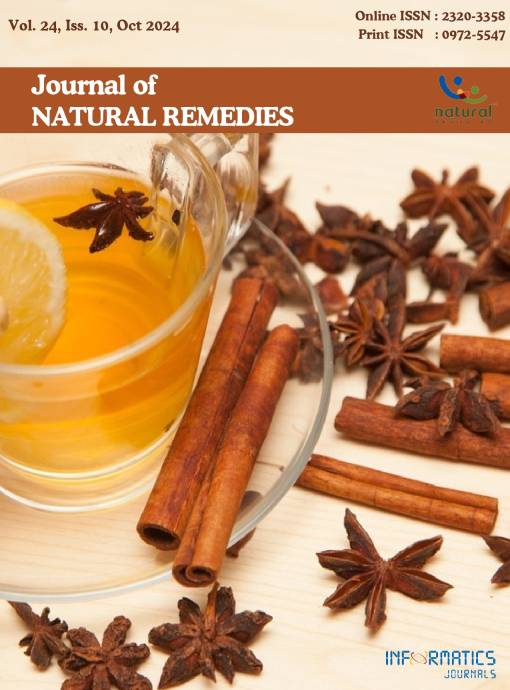Management of Plaque Psoriasis through Ayurveda - A Clinical Case Study
DOI:
https://doi.org/10.18311/jnr/2024/33676Keywords:
Ayurveda, Ekakushtha, Kushtha, Plaque Psoriasis, PsoriasisAbstract
Psoriasis is an immune-mediated inflammatory disease that affects the skin and joints and is chronic, non-communicable, painful, disfiguring and disabling. The prevalence of psoriasis in countries ranges from 0.09% to 11.4%. The reported prevalence in India is 0.44 - 2.8%. Even though psoriasis was found long ago, its etiology and treatment are not affirmative. Psoriasis can be correlated to Ekakushtha based on the signs and symptoms described in the classical texts of Ayurveda. Many herbs have been mentioned in Ayurveda to treat psoriasis, however due to the disease’s complicated pathophysiology and relapsing nature, there is need to develop a multimodal treatment protocol. We report a case of plaque psoriasis in a female patient aged 18 in this article. The prescribed course of action was created in accordance with the Ayurvedic-samprapti (pathology). Therapeutic emesis after improving digestion power was done followed by internal medicine Patoladigana decoction, Tablet Arogyavardhinivati, Tablet Gandhakrasayana and Mahatiktaka ghee was given along with Ayyapal oil for topical application on patches. During treatment and 1 year after completion of treatment diet and lifestyle modifications were strictly followed by the patient. Compared to earlier allopathic treatment, the efficacy of the treatment was observed substantially sooner. After treatment, there was no recurrence. During treatment, the wholesome diet as a health promoter was important. Time to time photographic documentation was maintained during whole year of treatment. Ayurvedic external and internal treatment can help to rectify the intricate patho-physiology of persistent psoriasis.
Downloads
Metrics
Downloads
Published
How to Cite
Issue
Section
License
Copyright (c) 2024 Ugale Swati Dasharath, Borude M. Indrajit, Swagata D. Tavhare, Mihir Hajarnavis (Author)

This work is licensed under a Creative Commons Attribution 4.0 International License.
Accepted 2024-08-12
Published 2024-11-06
References
Gibbs S. Skin disease and socioeconomic conditions in rural Africa: Tanzania. Int J Dermatol. 1996; 35(9):633-9. https://doi.org/10.1111/j.1365-4362.1996.tb03687.x PMid: 8876289
Danielsen K, Olsen AO, Wilsgaard T, Furberg AS. Is the prevalence of psoriasis increasing? A 30-year follow-up of a population-based cohort. Br J Dermatol. 2013; 168:130310. https://doi.org/10.1111/bjd.12230 PMid:23374051
Institute for Health Metrics and Evaluation (IHME). Global Burden of Disease Study, 2010: Results by Cause 1990-2010. Seattle: IHME; 2012.
Thappa DM, Munisamy M. Research on psoriasis in India: where do we stand? Indian J Med Res. 2017; 146(2):147-9. https://doi.org/10.4103/ijmr.IJMR_1296_17 PMid:29265013 PMCid:PMC5761022
Rendon A, Schakel K. Psoriasis pathogenesis and treatment. Int J Mol Sci. 2019; 20:1475. https://doi.org/10.3390/ ijms20061475 PMid:30909615 PMCid:PMC6471628
Pandit Kashinath Pandey and Dr. Gorakhnath Chaturvedi; Charak Samhita, SavimarshaVidyotini- Hindi Vyakhya; Chikitsasthana. 7(29-3):253. Varanasi; 2011; PubChaukhamba Sanskrit Sansthanapp.
Reali E, Brembilla NC. Editorial: Immunology of psoriatic disease. Front Immunol. 2019; 10:657. https://doi.org/10.3389/fimmu.2019.00657 PMid:30984203 PMCid: PMC6449451
Baliwag J, Barnes DH, Johnston A. Cytokines in psoriasis. Cytokine. 2015; 73(2):342e50. https://doi.org/10.1016/j.cyto.2014.12.014 PMid:25585875 PMCid:PMC4437803
Gaud BL, editor. (reprint). Astangahridaya of vagbhata, sootrasthana. 2013; 15(15): 256. Varanasi: Chaukhambha Orientalia.
Tripathi B, editor. (reprint). Charakasamhita of agnivesha, vimanasthan; Srotovimaniya: chapter 5, verse 144-150. Varanasi: Chaukhambha Surbharati Prakashana. 2013. p.327-8.
Ruela ALM, Perissinato AG, Lino ME de S, Mudrik PS, Pereira GR. Evaluation of skin absorption of drugs from topical and transdermal formulations. Braz J Pharm Sci. 2016; 52(3):527. https://doi.org/10.1590/s198482502016000300018
Shastri L, editor. (reprint). Yogaratnakar, uttarardh; Rasayanadhikar: verse 1-8. Varanasi: ChaukhmbhaPrakashan; 2010; 501-2.
Paradkar BH, editor, 6th edition. Ashtanga hridaya of Vagbhata, Uttara sthana; Chapter 35, Verse 50-54 . Bombay: Pandurang jawaji.1939; 905.
W. Stephen Parcel, sulfur in human nutrition and applications in medicine. Altern Med Rev. 2002; 7(1):2244.
Francis JA, Raja SN, Nair MG. Bioactive terpenoids and guggul steroids from Commiphoramukul gum resin of potential anti-inflammatory interest. Chem Biodivers. 2004; 1(11):1842-53. https://doi.org/10.1002/cbdv.200490138 PMid:17191820
Thappa DM, Dogra J. Nodulocystic acne: oral gugulipid versus tetracycline. J Dermatol (Tokyo). 1994; 21(10):729-31. https://doi.org/10.1111/j.1346-8138.1994.tb03277.x PMid:7798429
Varma SR, Sivaprakasam TO, Arumugam I, Dilip N, Raghuraman M, Pavan KB et al. In vitro anti-inflammatory and skin protective properties of virgin coconut oil. J Tradit Complement Med. 2019; 9(1):5-14. https://doi.org/10.1016/j.jtcme.2017.06.012
Shrivastava S. Sharangadharsamhita of acharya sharangadhar, Madhyamkhand; Vvataka Kalpana. chapter 7, verse 70-81, poorvakhand; paribhasha: chapter 1, verse 37, Chaukhambha Orientalia, Varanasi (2016) 204, pp10
Bharati PL, Agrawal P, Prakash O. A case study on the management of dry gangrene by kaishoreguggulu, sanjivanivati and dashangalepa ayu. 2019; 40(1):48-52. https://doi.org/10.4103/ayu.AYU_244_18 PMid:31831969 PMCid:PMC6891997
Ayurvedic formulary of India. Ministry of Health and Family Welfare, Department of ISM and H, New Delhi. 2003; 258.
Kuchewar V. A case study on successful ayurvedic management of a rare case of reiter’s syndrome. Ancient Sci Life. 2017; 36:225-58. https://doi.org/10.4103/asl.ASL_89_16 PMid:29269976 PMCid:PMC5726191
The Ayurvedic Pharmacopoeia of India, ‘Arogyavardhini Gutika’, Part I: 20:4, 2nd ed. Delhi: The Controller of Publications, Civil Lines. 2003; 664-5.
Ramchandra P, Basheermiya M, Krupadanam GL, Srimannarayana G. Wrightial, a new terpene from Wrightia tinctoria. J Nat Prod. 1993; 56(10):1811. https://doi.org/10.1021/np50100a022
Pandey G. Dravyagunavignana, part-2, krishnadas academy, Varanasi. Edition-1. 2001; 691.
Mohammad A. Alzohairy. Therapeutics role of Azadirachta indica (neem) and their active constituents in diseases prevention and treatment. Evidence-based complementary and alternative medicine. 2016. https:// doi.org/10.1155/2016/7382506 PMid:27034694 PMCid: PMC4791507
Baliwag J, Barnes DH, Johnston A. Cytokines in psoriasis cytokine. 2015; 73(2):342-50. https://doi.org/10.1016/j.cyto.2014.12.014 PMid:25585875 PMCid:PMC4437803
Varma SR, Sivaprakasam TO, Arumugam I, Dilip N, Raghuraman M, Pavan KB et al. In vitro anti-inflammatory and skin protective properties of virgin coconut oil. J Tradit Complement Med. 2019; 9(1):5-14. https://doi.org/10.1016/j.jtcme.2017.06.01

 Ugale Swati Dasharath
Ugale Swati Dasharath









 0.35
0.35 24
24 0.161
0.161